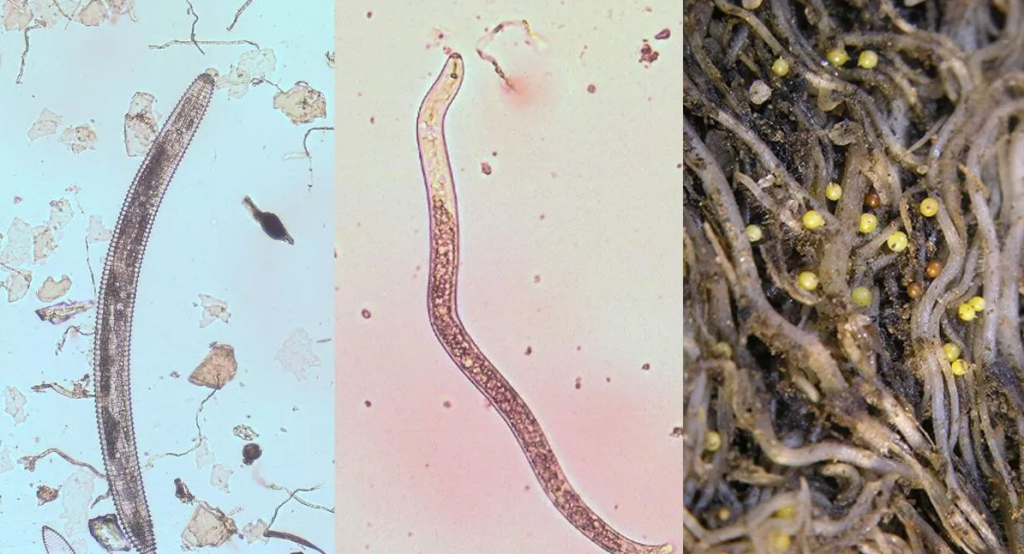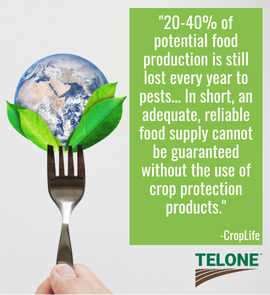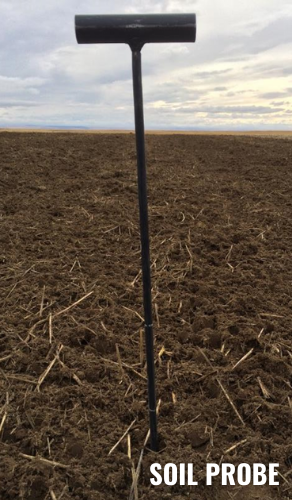SMART START
Effective pest management relies on understanding and controlling soil-borne pests, including plant-parasitic nematodes. Sampling for nematodes is a crucial part of a comprehensive Integrated Pest Management (IPM) plan. Identifying and quantifying nematode species allows for targeted control measures, reducing the need for broad-spectrum chemicals and enhancing sustainable practices. Soil fumigation with TELONE™ offers robust nematode control and integrates seamlessly with sustainable practices to promote long-term soil health and environmental stewardship.
This blog post covers a nematode overview, and the general steps growers can take to properly sample their soil ahead of planting. For a more detailed look at nematodes, check out our previous “What Are Nematodes” blog post.
WHAT ARE NEMATODES?

Nematodes are microscopic round worms found in the soil. While most nematode species do not harm plants, some are plant-parasitic (PPNs) and detrimental to plant growth and development. PPNs feed on root tissue impairing water and nutrient uptake, and opening pathways for secondary infections. These PPNs are considered a global threat to food security, causing more than $157 billion in worldwide crop losses annually!

EFFECTIVE SAMPLING TECHNIQUES
- TIMING: Pulling samples at peak populations will give the best representation of what is in the field. Try to sample just before harvest when plants are still growing. Typically, late summer/early fall, depending on the crop. Preplant can also be used but is not preferred. Soil should be moist.
- TOOLS: Use a soil probe to collect samples from the root zone. This will be between 8-12 inches deep depending on the crop.
- COLLECTION: To accurately sample nematodes, follow these steps:
- FIELD REPRESENTATION: Each sample should represent an area of 10-20 acres and consist of at least 20-30 core samples.
- MIXING AND STORAGE: Thoroughly mix the cores, place one quart of the mixed sample into a sealed plastic bag, and store it in a cool, shaded area to prevent sample deterioration. Label with intended crop information and send to nematology lab as quickly as possible.
- SAMPLING PATTERN: Collect soil cores in a “W” pattern across the field to ensure representative coverage. Include root fragments. Include “stressed areas” and historically low-yielding areas of the field.
- TARGET AREA: Insert the soil probe within the root zone of the existing crop. Ideally, the samples would be taken a few inches from the base of the plant in the area where smaller roots exist.

SAMPLE ANALYSIS
Private and university nematology labs are located throughout the country and specialize in identifying nematode species in soil samples. After conducting a thorough analysis, a report will be generated based on the number of nematodes found in a specific amount of soil. Growers can use this information to make informed decisions about managing these pests through chemical, cultural, or crop selection strategies.
MANAGEMENT DECISIONS
- CULTURAL PRACTICES: Rotate crops with non-host plants to reduce nematode populations. Use cover crops that suppress nematode populations outside of the primary growing season.
- RESISTANT VARIETIES: Some crops have either natural or bred traits that make them less susceptible to nematodes.
- BIOLOGICAL CONTROLS: Introducing natural predators or pathogens, such as certain fungi, bacteria, or predatory nematodes, can have impact on PPNs.
- CHEMICAL CONTROLS: Pre-plant nematicides like TELONE™ offer powerful control of nematodes, particularly for crops where nematodes lead to significant losses. They can be applied precisely where nematodes are in the soil and rapidly reduce populations—all before any crops are ever planted. This creates a zone of protection which allows crops to establish robust root systems to fight off other pests. Growers can also feel good knowing that prepping the soil ahead of planting leaves behind zero residuals and never comes in contact with the food supply.
CONCLUSION
Nematodes are a significant problem in modern cropping systems. Using TELONE™ to reduce these pest populations, will support global efforts to increase food production and security. By integrating TELONE™ into sustainable pest management strategies, farmers can achieve higher yields and better-quality crops while promoting environmental health and sustainability. This balanced approach is essential for meeting the food demands of a growing global population.
REMEMBER, THERE’S NO COMING BACK FROM A POOR START!
Disclaimer:
The resources and information provided are meant purely for educational discussion, contains only general information about legal matters, and is not to be construed as advice. Please note that any information or resources provided are not legal or regulatory advice, and should not be treated as such. You must not rely on the information provided as an alternative to legal advice from your attorney or other professional services. Teleos Ag encourages readers to consult with counsel, and their local, county, and state regulators. We make no representations or warranties, express or implied, in relation to the information provided through our resources and blog posts. It is the readers responsibility to know the laws related to 1,3- D, appropriate PPE, Licensing, etc., in his or her City, County, State, and Country.
- EQUIPMENT COMPATIBILITY: METAL SELECTION FOR TELONE™ by TELEOS SOIL FUMIGANT - December 16, 2025
- STORAGE SECURITY FOR TELONE™ by TELEOS - October 16, 2025
- TIP SHEET: PLACARDING FOR BULK SHIPMENT RETURNS - August 15, 2025


